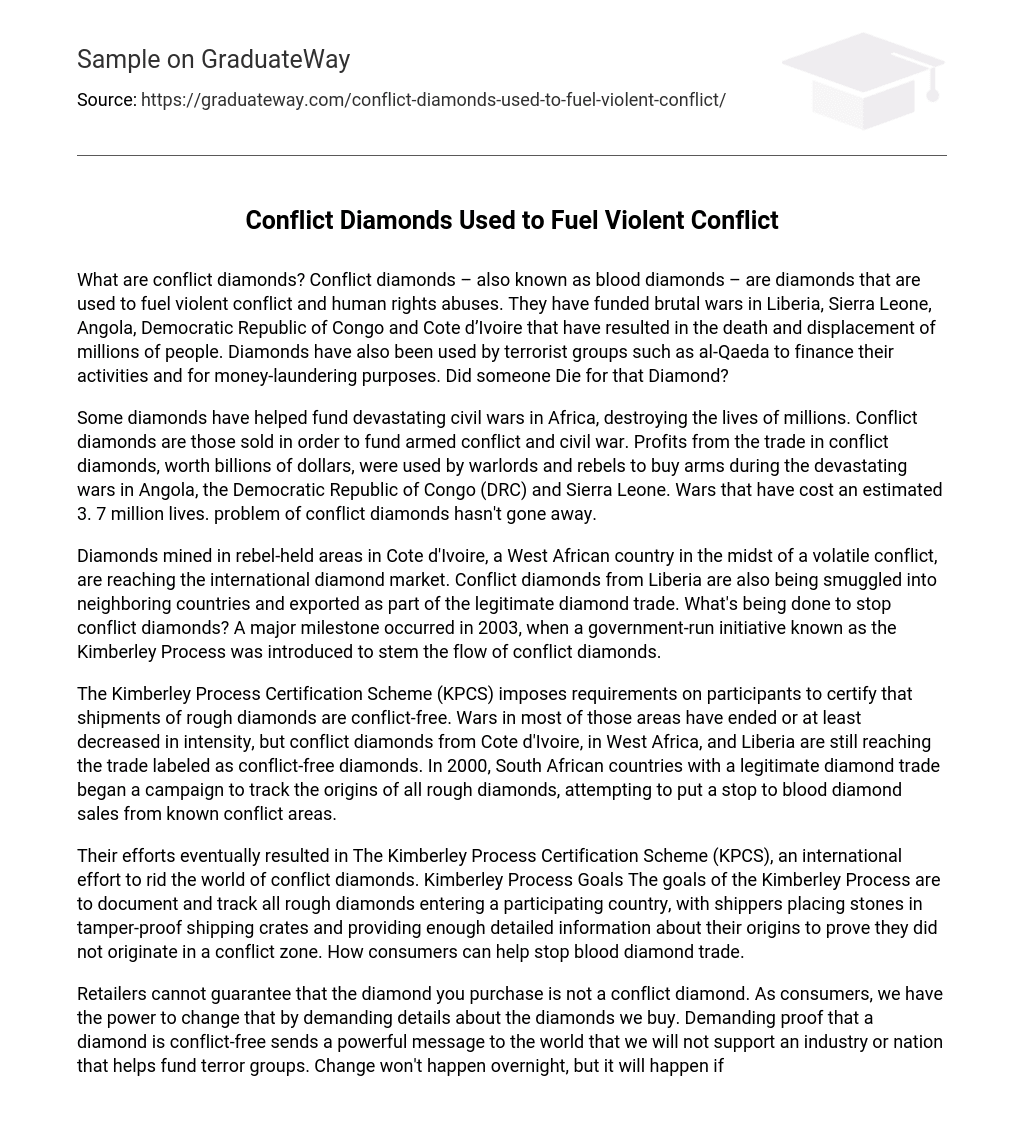What are conflict diamonds? Conflict diamonds – also known as blood diamonds – are diamonds that are used to fuel violent conflict and human rights abuses. They have funded brutal wars in Liberia, Sierra Leone, Angola, Democratic Republic of Congo and Cote d’Ivoire that have resulted in the death and displacement of millions of people. Diamonds have also been used by terrorist groups such as al-Qaeda to finance their activities and for money-laundering purposes. Did someone Die for that Diamond?
Some diamonds have helped fund devastating civil wars in Africa, destroying the lives of millions. Conflict diamonds are those sold in order to fund armed conflict and civil war. Profits from the trade in conflict diamonds, worth billions of dollars, were used by warlords and rebels to buy arms during the devastating wars in Angola, the Democratic Republic of Congo (DRC) and Sierra Leone. Wars that have cost an estimated 3. 7 million lives. problem of conflict diamonds hasn’t gone away.
Diamonds mined in rebel-held areas in Cote d’Ivoire, a West African country in the midst of a volatile conflict, are reaching the international diamond market. Conflict diamonds from Liberia are also being smuggled into neighboring countries and exported as part of the legitimate diamond trade. What’s being done to stop conflict diamonds? A major milestone occurred in 2003, when a government-run initiative known as the Kimberley Process was introduced to stem the flow of conflict diamonds.
The Kimberley Process Certification Scheme (KPCS) imposes requirements on participants to certify that shipments of rough diamonds are conflict-free. Wars in most of those areas have ended or at least decreased in intensity, but conflict diamonds from Cote d’Ivoire, in West Africa, and Liberia are still reaching the trade labeled as conflict-free diamonds. In 2000, South African countries with a legitimate diamond trade began a campaign to track the origins of all rough diamonds, attempting to put a stop to blood diamond sales from known conflict areas.
Their efforts eventually resulted in The Kimberley Process Certification Scheme (KPCS), an international effort to rid the world of conflict diamonds. Kimberley Process Goals The goals of the Kimberley Process are to document and track all rough diamonds entering a participating country, with shippers placing stones in tamper-proof shipping crates and providing enough detailed information about their origins to prove they did not originate in a conflict zone. How consumers can help stop blood diamond trade.
Retailers cannot guarantee that the diamond you purchase is not a conflict diamond. As consumers, we have the power to change that by demanding details about the diamonds we buy. Demanding proof that a diamond is conflict-free sends a powerful message to the world that we will not support an industry or nation that helps fund terror groups. Change won’t happen overnight, but it will happen if we are persistent. What is the Kimberley Process? The Kimberley Process is a certification system that prevents conflict diamonds from entering the legitimate diamond supply chain.
The Kimberley Process ensures that only rough diamonds accompanied by a government-issued certificate can be imported and exported, providing an assurance that the diamonds are from sources free from conflict. Under this, United Nations backed, system, only the 69 countries (as of July 2006) that are part of the Kimberley Process can import or export rough diamonds. Anyone who trades in rough diamonds without a Kimberley Process certificate in these countries is breaking the law. When did conflict diamonds emerge?
Conflict diamonds came to the attention of the world’s media in the late 1990s during the extremely brutal conflict in Sierra Leone. Conflicts have occurred in some of the poorest parts of Africa for many decades. In recent times these conflicts have often focused on rebels controlling their country’s natural resources, for example oil, wood, minerals and diamonds. Often rebels will trade these assets for arms and influence. Some rebel groups sold diamonds to generate funds for buying their arms – these diamonds are known as conflict diamonds. To learn more visit Conflict Diamonds: Background. Return to Top





